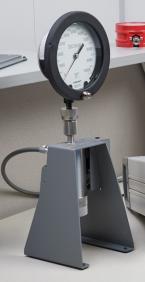- Other Fluke companies:
- Fluke
- Fluke Biomedical
- Fluke Networks
- Fluke Process Instruments
Mixing fluids in a high-pressure calibration without fear of contamination
Pressure calibration involves applying the same pressure to a reference device (standard), and the device you wish to calibrate (device under test or DUT). The pressure is transmitted to the two devices across some medium, perhaps nitrogen gas or oil. This seems simple enough, but what happens if the two devices don’t operate in the same medium, or if contamination is transferred through the medium? This can cause problems such as damaged devices, bad calibrations, and contaminated processes. The good news is, there are solutions.
Contamination coming from the standard or the medium itself
Most low-pressure calibrations are performed using nitrogen or a similar clean, dry air as a medium. This works well and causes few problems. The only challenge is to ensure that the proper grade of nitrogen is acquired. There are a couple of scenarios where the medium can cause a problem.
One potential issue is when the medium is not compatible with the DUT or the process where the DUT will be used. For example, a deadweight tester is designed to be used with a specific type of oil. Converting to a different type of oil can cause measurement errors or even damage to the piston-cylinder. Unfortunately, the oil used in the calibration is often not the same oil used in the process where the DUT is then used. This cross-contamination can cause problems. One solution is to use gas, like nitrogen, as the medium. This can be done by using a pneumatic high-pressure controller, like the Fluke Calibration 8270A or 8370A. This requires a supply of high-pressure gas, which can be provided using a standard nitrogen cylinder and the available gas booster kit.
This leads to the next question. If the DUT has oil in it, how do you keep it from contaminating the gas pressure controller? This is where the optional Contamination Prevention System (CPS) comes in. The CPS protects the pressure controller from contamination coming from the DUT. When controlling up in pressure, the gas media goes from the controller, through the CPS, to the DUT. When controlling down in pressure, the now contaminated gas media is exhausted through the CPS and never travels back to the controller. In addition, the CPS acts as a gravity trap with a filter to capture any additional contaminates.
A pneumatic pressure controller combined with the CPS can be used to calibrate almost any pressure device, regardless of what media the device normally operates in. It eliminates messy oil from your pressure calibration laboratory and is easier to use than manual devices like deadweight testers.
Other articles that you may find interesting
High-pressure calibration and characterization in a production process
Performing high-pressure calibration
- Login or register to post comments
- Printer-friendly version »
- Home
- Products
- New Products
- Electrical Calibration
- RF Calibration
- Data Acquisition and Test Equipment
- Temperature Calibration
- Humidity Calibration
- Pressure Calibration
- Flow Calibration
- Process Calibration Tools
- Calibration Software
- Service and Support
- All Calibration Instruments
- Purchase Info
- News
- Training and Events
- Literature and Education
- Service and Support
- About Us


